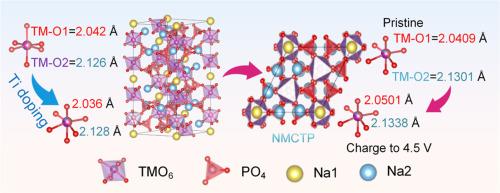Crystal field–driven local structure engineering enables high-voltage redox and structural durability in polyanion cathode for sodium-ion batteries
IF 20.2
1区 材料科学
Q1 CHEMISTRY, PHYSICAL
引用次数: 0
Abstract
The (Na Super Ionic Conductor) NASICON-type Na4MnCr(PO4)3 (NMCP) cathode, while attractive for its high operating voltage, faces critical challenges including sluggish electron transport, unstable cycling behavior, Cr redox inactivity, and structural deterioration. To address these issues, a Ti-substituted derivative, Na3.55Mn0.85Cr0.85Ti0.3(PO4)3 (NMCTP), was developed through strategic cation engineering. The partial replacement of Mn and Cr with Ti optimizes the local transition metal coordination environment, activating Cr redox reactions, reinforcing structural integrity, and enhancing both electronic conductivity and Na+ transport kinetics. As a result, NMCTP delivers a high-rate capacity and long-term stability, achieving 82.2 mAh g−1 at 10 C with 80.5 % capacity retention after 2000 cycles. Even under ultrafast cycling at 50 C, it maintains a capacity of 40.7 mAh g⁻1. In-situ X-ray analysis reveals a hybrid Na+ storage mechanism involving solid-solution and biphasic transitions with only 5.6 % volume change, underscoring the structural robustness of the material. when paired with a hard carbon (HC) anode, the NMCTP//HC full cell delivers a discharge capacity of 131.2 mAh g−1 at 80 mA g−1 and achieves a high energy density of 403.7 Wh kg−1 (based on cathode mass). This study demonstrates the efficacy of targeted cation substitution in optimizing polyanionic frameworks and provides a viable route toward high-energy, long-life sodium-ion batteries.


晶体场驱动局部结构工程实现钠离子电池聚阴离子阴极的高压氧化还原和结构耐久性
(Na超级离子导体)nasiconon型Na4MnCr(PO4)3 (NMCP)阴极虽然因其高工作电压而具有吸引力,但面临着电子传递缓慢、循环行为不稳定、Cr氧化还原不活性和结构劣化等严峻挑战。为了解决这些问题,通过战略阳离子工程,开发了ti取代衍生物Na3.55Mn0.85Cr0.85Ti0.3(PO4)3 (NMCTP)。用Ti部分取代Mn和Cr优化了局部过渡金属配位环境,激活了Cr氧化还原反应,增强了结构完整性,提高了电子导电性和Na+输运动力学。因此,NMCTP提供了高倍率容量和长期稳定性,在10℃下达到82.2 mAh g- 1, 2000次循环后容量保持率为80.5%。即使在50℃的超快循环下,它也能保持40.7毫安时的容量。原位x射线分析揭示了Na+的混合存储机制,包括固溶和双相转变,只有5.6%的体积变化,强调了材料的结构坚固性。当与硬碳(HC)阳极配对时,NMCTP//HC全电池在80 mA g - 1时提供131.2 mAh g - 1的放电容量,并实现403.7 Wh kg - 1的高能量密度(基于阴极质量)。这项研究证明了靶向阳离子取代在优化聚阴离子框架方面的有效性,并为高能、长寿命钠离子电池提供了一条可行的途径。
本文章由计算机程序翻译,如有差异,请以英文原文为准。
求助全文
约1分钟内获得全文
求助全文
来源期刊

Energy Storage Materials
Materials Science-General Materials Science
CiteScore
33.00
自引率
5.90%
发文量
652
审稿时长
27 days
期刊介绍:
Energy Storage Materials is a global interdisciplinary journal dedicated to sharing scientific and technological advancements in materials and devices for advanced energy storage and related energy conversion, such as in metal-O2 batteries. The journal features comprehensive research articles, including full papers and short communications, as well as authoritative feature articles and reviews by leading experts in the field.
Energy Storage Materials covers a wide range of topics, including the synthesis, fabrication, structure, properties, performance, and technological applications of energy storage materials. Additionally, the journal explores strategies, policies, and developments in the field of energy storage materials and devices for sustainable energy.
Published papers are selected based on their scientific and technological significance, their ability to provide valuable new knowledge, and their relevance to the international research community.
 求助内容:
求助内容: 应助结果提醒方式:
应助结果提醒方式:


